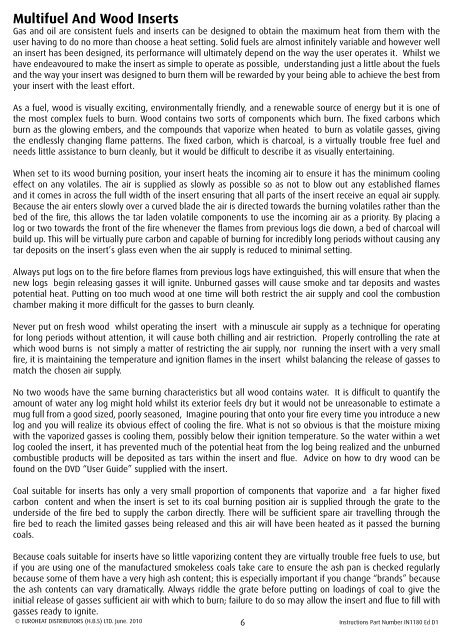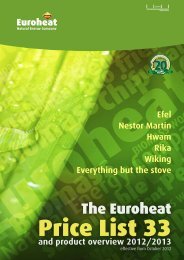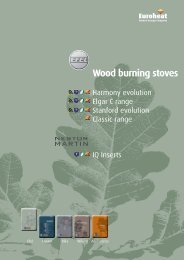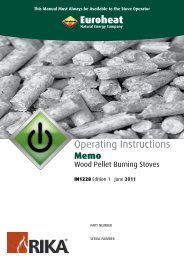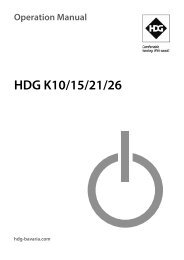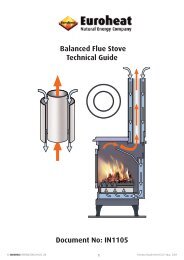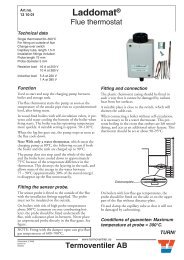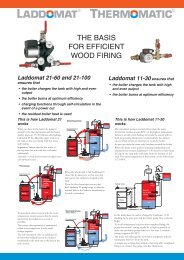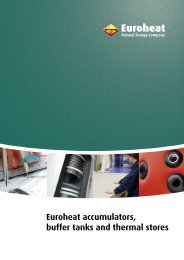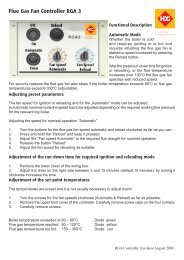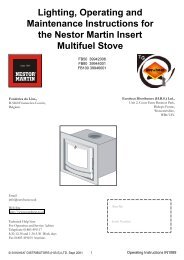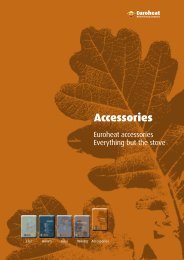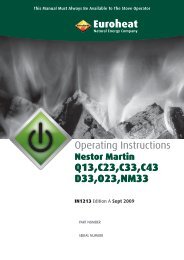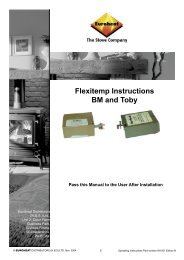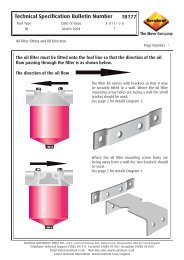IT13 Operation - Euroheat
IT13 Operation - Euroheat
IT13 Operation - Euroheat
Create successful ePaper yourself
Turn your PDF publications into a flip-book with our unique Google optimized e-Paper software.
Multifuel And Wood Inserts<br />
Gas and oil are consistent fuels and inserts can be designed to obtain the maximum heat from them with the<br />
user having to do no more than choose a heat setting. Solid fuels are almost infinitely variable and however well<br />
an insert has been designed, its performance will ultimately depend on the way the user operates it. Whilst we<br />
have endeavoured to make the insert as simple to operate as possible, understanding just a little about the fuels<br />
and the way your insert was designed to burn them will be rewarded by your being able to achieve the best from<br />
your insert with the least effort.<br />
As a fuel, wood is visually exciting, environmentally friendly, and a renewable source of energy but it is one of<br />
the most complex fuels to burn. Wood contains two sorts of components which burn. The fixed carbons which<br />
burn as the glowing embers, and the compounds that vaporize when heated to burn as volatile gasses, giving<br />
the endlessly changing flame patterns. The fixed carbon, which is charcoal, is a virtually trouble free fuel and<br />
needs little assistance to burn cleanly, but it would be difficult to describe it as visually entertaining.<br />
When set to its wood burning position, your insert heats the incoming air to ensure it has the minimum cooling<br />
effect on any volatiles. The air is supplied as slowly as possible so as not to blow out any established flames<br />
and it comes in across the full width of the insert ensuring that all parts of the insert receive an equal air supply.<br />
Because the air enters slowly over a curved blade the air is directed towards the burning volatiles rather than the<br />
bed of the fire, this allows the tar laden volatile components to use the incoming air as a priority. By placing a<br />
log or two towards the front of the fire whenever the flames from previous logs die down, a bed of charcoal will<br />
build up. This will be virtually pure carbon and capable of burning for incredibly long periods without causing any<br />
tar deposits on the insert’s glass even when the air supply is reduced to minimal setting.<br />
Always put logs on to the fire before flames from previous logs have extinguished, this will ensure that when the<br />
new logs begin releasing gasses it will ignite. Unburned gasses will cause smoke and tar deposits and wastes<br />
potential heat. Putting on too much wood at one time will both restrict the air supply and cool the combustion<br />
chamber making it more difficult for the gasses to burn cleanly.<br />
Never put on fresh wood whilst operating the insert with a minuscule air supply as a technique for operating<br />
for long periods without attention, it will cause both chilling and air restriction. Properly controlling the rate at<br />
which wood burns is not simply a matter of restricting the air supply, nor running the insert with a very small<br />
fire, it is maintaining the temperature and ignition flames in the insert whilst balancing the release of gasses to<br />
match the chosen air supply.<br />
No two woods have the same burning characteristics but all wood contains water. It is difficult to quantify the<br />
amount of water any log might hold whilst its exterior feels dry but it would not be unreasonable to estimate a<br />
mug full from a good sized, poorly seasoned, Imagine pouring that onto your fire every time you introduce a new<br />
log and you will realize its obvious effect of cooling the fire. What is not so obvious is that the moisture mixing<br />
with the vaporized gasses is cooling them, possibly below their ignition temperature. So the water within a wet<br />
log cooled the insert, it has prevented much of the potential heat from the log being realized and the unburned<br />
combustible products will be deposited as tars within the insert and flue. Advice on how to dry wood can be<br />
found on the DVD “User Guide” supplied with the insert.<br />
Coal suitable for inserts has only a very small proportion of components that vaporize and a far higher fixed<br />
carbon content and when the insert is set to its coal burning position air is supplied through the grate to the<br />
underside of the fire bed to supply the carbon directly. There will be sufficient spare air travelling through the<br />
fire bed to reach the limited gasses being released and this air will have been heated as it passed the burning<br />
coals.<br />
Because coals suitable for inserts have so little vaporizing content they are virtually trouble free fuels to use, but<br />
if you are using one of the manufactured smokeless coals take care to ensure the ash pan is checked regularly<br />
because some of them have a very high ash content; this is especially important if you change “brands” because<br />
the ash contents can vary dramatically. Always riddle the grate before putting on loadings of coal to give the<br />
initial release of gasses sufficient air with which to burn; failure to do so may allow the insert and flue to fill with<br />
gasses ready to ignite.<br />
© EUROHEAT DISTRIBUTORS (H.B.S) LTD. June. 2010 6<br />
Instructions Part Number IN1180 Ed D1


